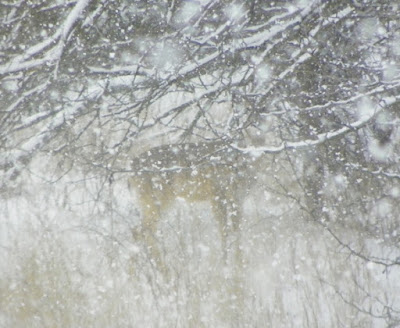Again
this year I got a call from a representative of the Missouri Department of
Conservation asking me to hunt deer on my place because they want to thin down
the population and check more deer for transmissible spongiform encephalopathy,
which they and most deer hunters call chronic wasting disease.
Whether
you call it CWD or TSE, the possibility of controlling the disease by killing
more deer is not very realistic. They have tried that in Wisconsin. The
result…some parts of that state have 50% of the deer population infected with
those TSE prions in the brain. In time Missouri’s whitetail deer will show
similar numbers.
I
am going to select a buck from my place, not because I think I have any kin of
population there, I don’t. I’m going to shoot one because a nearby family with
five kids can sure use the meat.
I
didn’t hunt deer this year during the regular season. I am just not as excited
about hunting deer with a gun nowadays, but I do like shooting them with a
camera.
I
will kill a buck or mature doe because young deer are far less likely to have
CWD or TSE than older ones. Research in other states has shown this to be true.
If I were betting, I would bet that few deer under the age of two years are
found to have prions in their system. In fact tests done in selected deer
farming operations seems to show that it is three and four year old deer that
are more likely to be infected than younger deer and bucks seem to be more
likely to have the disease than does by about a three to two ratio.
When
I kill a deer I will use rubber gloves to gut it, and an MDC representative
will come and take lymph nodes from the neck and within a week or so they will
know if it is free of prions. Then I will give the meat to the family nearby.
At
my place there is no heavy population of deer but they don’t know that. Anyone
who spends as much time in the woods as I do can easily gauge deer numbers in
the winter by the number of rubs and scrapes, and just by seeing the number of
does and young deer which herd together in bad weather.
To
the northwest of my place, which lies in the southeast corner of St. Clair
county, I can see evidence of too many deer, but in the 200 acres or so around
me there has been a great deal of illegal hunting in the past and numbers are
where they should be. The old man
who owned the land before me killed four or five deer each year and traded them
to some Amish folks living a few miles away for firewood-cutting labor. He turned in a neighbor who had
arranged several tree-stands over active corn feeders for friends and family. Together
they likely accounted for a kill of 20 or so deer each year.
It’s
different though with wild turkey.
Their numbers have declined everywhere I go, for the last five or six
years, to a point where I think it is a serious problem. I think needs to be
addressed right now, perhaps by cutting the legal limit from two per spring
season to only one.
Ten
years ago here on Lightnin’ Ridge in central Polk County, I photographed seven
mature gobblers at my corn feeder in February. A year or so later there were 3. This year there are none. And I haven’t killed a gobbler on this wooded ridge-top in
the last 15 years.
The
biggest enemies of the wild turkey are great horned owls and bobcats. Both of those
have increased substantially in ten years, but not enough to be responsible for
the wild turkey’s problems. You can blame heavy spring rains which kill young
poults, but not a factor for consecutive years like this. It is possible that a disease could be
responsible, as ever-increasing big poultry operations springing up everywhere
have seen thousands of chickens die almost overnight from one disease or
another. But I figure what is
responsible for this alarming decrease in wild turkey numbers is the same dilemma
faced by quail, woodcock and whippoorwills--- overwhelming numbers of ground-foraging
egg-eaters… raccoons, skunks, possums and snakes, and something unseen here 30
years ago….armadillos.
Whatever
it is, I don’t see anyway to change things. Any ground nester is going to be hard pressed to exist in
the future in the numbers we want.
Landowners need to declare war on armadillos especially. And if you get feral hogs on your land,
set a pair of chicken eggs out in a protected area where they thrive and see
how long those eggs last.
I read this recently
from a study being done in Minnesota.
Notice what they say is of the biggest concern here.
----“CWD, caused by mutated
proteins called prions, already has crossed species to macaque monkeys that
were fed infected meat in laboratory tests. Dr. Michael Osterholm, director of
the Center for Infectious Disease Research and Policy at the University of
Minnesota and an expert on infectious diseases, puts the human danger bluntly.
"I do believe that
it is not a matter of if, but when, CWD crosses to humans,'' Osterholm said.
To which Michelle
Carstensen, wildlife health program group leader for the Minnesota Department
of Natural Resources, replied, "That's the biggest scare with this disease
— what that would do to deer hunting and wildlife management!”
Write to me at Box 22,
Bolivar, Mo 65613 or email lightninridge47@gmail.com. To enquire about my books or the
outdoor magazine we produce, call my office at 417-777-5227.








